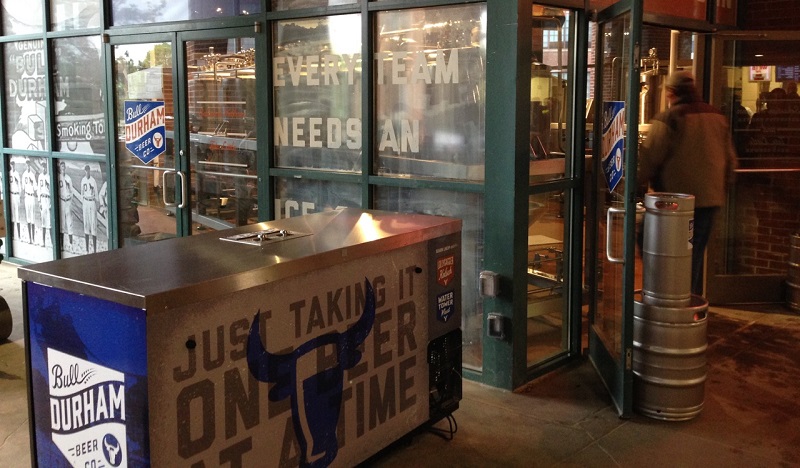Pull Up A Stool With Sebastian Wolfrum
of Bull Durham Beer Co.

Bull Durham Beer Co. brews on a 2.5-barrel brewery inside the Durham Bulls Athletic Park. (Photo courtesy Bull Durham Beer Co.)
This interview appears in the beer guide for the World Beer Festival Durham, produced by All About Beer Magazine. Attendees to our Seasonal Beer Showcase on Friday, Oct. 9 and the festival itself on Saturday, Oct. 10 will be able to sample Bull Durham Beer Co.’s beers. Tours of the ballpark’s new brewery will be offered to those in attendance Friday night and to VIP ticket holders on Saturday.
Triangle baseball fans now have another reason to be excited about going to a Durham Bulls game—Bull Durham Beer Co., led by Sebastian Wolfrum. Before moving to the Triangle 10 years ago, Seabass, as his friends know him, brewed at Ayinger Brewery in Aying, Germany. The brewery has the whole town, if not the region, under its spell. People come to the brewery to soak up the atmosphere.
Wolfrum used to spend Fridays helping with the packaging, wondering where all the beer in cardboard cartons went. Then he moved here and found the beers widely distributed in the U.S.

Sebastian Wolfrum is the executive brewmaster for Bull Durham Beer Co., a new brewery inside the Durham Bulls Athletic Park. (Photo courtesy Bull Durham Beer Co.)
All About Beer: What’s it like brewing on such a small system?
Sebastian Wolfrum: Brewing in a small space, on a 2.5-barrel system, is a lot of fun, especially for a brewer like me with a large-scale brewery background. I have two 50-pound bags of malt for a brew and that’s it. There is a playfulness that allows more room for experimentation and innovation. And we can make huge differences with the slightest change, like adding a new pump improves the efficiencies immensely.
What were your offerings during this baseball season?
This summer we just brewed a wheat and a Kölsch. The wheat is a Bavarian style with a lot of tartness and not all of the fruity notes of a more traditional wheat—perfect for a ballpark. The Kölsch is very solid without a lot of silliness. It finishes dry and refreshing. The lower alcohol gives a lot of room for the main ingredients to shine.
How did it go this season?
Our first baseball season ended without having to take taps from other brewers. We also doubled our projections. Our 2.5-barrel system was put under a lot of strain. We did just a bit over a batch a game.
How did the other breweries and customers respond?
The beer is only sold right outside of the brewery itself. No taps from other breweries were taken over. We just have the two taps connected to a bottom-filling draft station. We keep running out, all the time. It could grow into something big! What’s also nice is you can come in and chat with the brewing team during the baseball games.
What will the offseason bring?
During the offseason we’re going to go out into the market and get involved with a lot of beer festivals. We haven’t been out of the ballpark since we started. We have a pop-up bar at the Contemporary Art Museum for six weeks. We’re making a nice Oktoberfest beer. We will also have a couple of taps on Duke campus.
Beginning next year we will have a taproom in the hotel being built adjacent to the ballpark. To keep up with this demand, we will be adding four more tanks to double capacity to be ready for next season.
What was it like when you first came to the Triangle?
When I arrived in the Triangle, Pop the Cap [the movement to lift North Carolina’s 6% cap on alcohol in beer] had just started. There were only 25 breweries in the state. I joined a brewpub, Natty Greene’s, which we grew into other locations and a distributing brewery, selling over 15,000 barrels.
How has the industry changed?
Around 2010, the next generation entered the market, breweries such as Olde Mecklenburg, Aviator, Lonerider. The amazing N.C. beer adventure began.
By the mid 2000s, the elements of the industry started to shift, with all of the pieces having moved. Foothills and Natty Greene’s started as brewpubs. All were experienced in breweries or restaurants.
The next generation were largely career changers. They largely skipped over the brewpub stage. The tap rooms were what made these breweries financially successful. Before, it was brewpubs then production breweries with tap rooms. It was hard to understand people going into a brewery just to drink.
I remember at my first CBC [Craft Brewers Conference] the count was always twice as many brewpubs as breweries. And then it flip-flopped as production breweries got into selling beer directly.
The rise in appreciation created the demand.
Coming from Germany, what surprised you the most about the North Carolina craft beer market?
People would go to a brewery just to drink the beer. Going to a brewery taproom created the base for this industry. It was all part of this farmer’s market, farm-to-fork movement.
You’ve seen both sides—brewpubs and distributing breweries. How has that evolved?
It is hard to sell a lot of beer in bars, restaurants and grocery stores. There are a lot of cost margins that are very challenging. None of this is in play with taprooms.
Then canning made great strides opening up packaging opportunities, but the bottle remains the class act. Mobile canning is making great inroads into helping breweries get to market. Still, the bottle and the six-pack carrier remain king.
What do you think of the beers now being made in the Triangle?
Overall, I see an uptick in quality and craftsmanship. With all of the competition, brewery owners make sure to have it right on day one. They are no longer doing it wishy-washy. Overall standards are in the right direction.
I had expected to see more funky beers, but the trend seems to be receding. Instead, we have a strong resurgence of the classics, like the pils. This reflects a self-confidence, because these beers are very difficult to make.
How did you end up running Bull Durham Beer Co.?
After leaving Natty Greene’s I had planned on opening a malting company. While preparing that business, I consulted with various companies including the Goodmons’ [the family that owns the Bulls] Rocky Mount Mills project.
The Goodmons viewed this beautiful mill, founded in 1818, as the spur for redevelopment and revitalization of the downtown. They came up with the brewery incubator concept that would bring together a community of brewers, which would impact the downtown. This has been a standard for craft beer. Take Sean [Lilly Wilson] and Fullsteam. There was nothing there when he looked at the facility. Now it is the hot, vibrant area of Durham.
What drives the brewery?
Philosophy behind Bull Durham Beer Co. is captured in a hot summer night, the crack of the bat, really dusty, twilight, with beers under 5%. This really works in this setting.
The Durham Bulls [have] a highly craft-beer-centric ballpark with 17 different craft beers on tap. Hey, it’s Durham, where people really know their stuff about food and beer. [The] stadium is unique because of the fans, the atmosphere and the region.
This interview was conducted and edited by Daniel Bradford.
Go to the next page to learn more about Sebastian Wolfrum.
Click here to read more conversations with brewers.

Leave a Reply